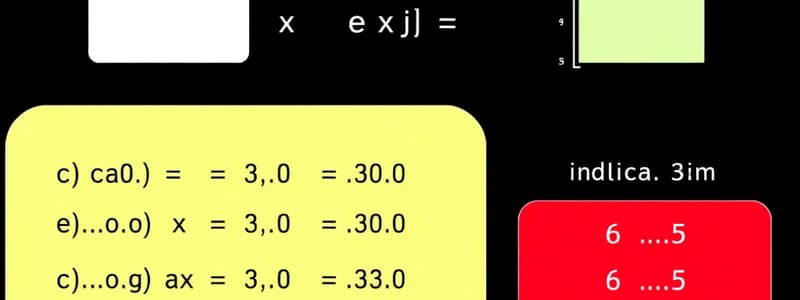Podcast
Questions and Answers
In a Chi-Square test of independence, what does the null hypothesis ($H_0$) typically state?
In a Chi-Square test of independence, what does the null hypothesis ($H_0$) typically state?
- The variables are dependent.
- The variables are associated.
- The variables are independent. (correct)
- There is a significant relationship between the variables.
What does the alternative hypothesis ($H_A$) suggest in a Chi-Square test of independence?
What does the alternative hypothesis ($H_A$) suggest in a Chi-Square test of independence?
- There is no relationship between the variables.
- The variables are dependent. (correct)
- The variables are independent.
- The variables have equal variances.
Which formula is used to calculate the degrees of freedom ($df$) in a Chi-Square test of independence for a two-way table?
Which formula is used to calculate the degrees of freedom ($df$) in a Chi-Square test of independence for a two-way table?
- $df = R \times C$
- $df = (R - 1) \times (C - 1)$ (correct)
- $df = (R - 1) + (C - 1)$
- $df = (R + 1) \times (C + 1)$
The chi-squared test statistic formula is given by $X^2 = \sum \frac{(O - E)^2}{E}$. What do 'O' and 'E' represent in this formula?
The chi-squared test statistic formula is given by $X^2 = \sum \frac{(O - E)^2}{E}$. What do 'O' and 'E' represent in this formula?
In the context of a Chi-Square test, how is the expected count for a cell in a two-way table calculated?
In the context of a Chi-Square test, how is the expected count for a cell in a two-way table calculated?
What does a large p-value (e.g., greater than 0.05) indicate in a Chi-Square test of independence?
What does a large p-value (e.g., greater than 0.05) indicate in a Chi-Square test of independence?
What does the Chi-Square test of independence help to determine?
What does the Chi-Square test of independence help to determine?
Given a two-way table with 3 rows and 4 columns, what are the degrees of freedom ($df$) for the Chi-Square test?
Given a two-way table with 3 rows and 4 columns, what are the degrees of freedom ($df$) for the Chi-Square test?
In a Chi-Square test, if the calculated test statistic is large and the p-value is small (e.g., less than 0.05), what decision should be made regarding the null hypothesis?
In a Chi-Square test, if the calculated test statistic is large and the p-value is small (e.g., less than 0.05), what decision should be made regarding the null hypothesis?
Which of the following is a critical assumption for the Chi-Square test of independence to be valid?
Which of the following is a critical assumption for the Chi-Square test of independence to be valid?
If the p-value in a Chi-Square test is 0.65, what conclusion can be drawn?
If the p-value in a Chi-Square test is 0.65, what conclusion can be drawn?
In the example data provided regarding popular kids, what are the two categorical variables being analyzed for independence?
In the example data provided regarding popular kids, what are the two categorical variables being analyzed for independence?
Using the 'Popular kids' dataset, if the calculated Chi-Square statistic is 1.3121 with 4 degrees of freedom, what is the correct interpretation based on the provided p-value range?
Using the 'Popular kids' dataset, if the calculated Chi-Square statistic is 1.3121 with 4 degrees of freedom, what is the correct interpretation based on the provided p-value range?
Based on the Chi-Square test results from the 'Popular kids' dataset, what is the appropriate conclusion regarding the relationship between grade and goals?
Based on the Chi-Square test results from the 'Popular kids' dataset, what is the appropriate conclusion regarding the relationship between grade and goals?
Suppose a researcher aims to use a Chi-Square test of independence. Which type of data should they collect?
Suppose a researcher aims to use a Chi-Square test of independence. Which type of data should they collect?
A study finds a significant association between smoking status and the occurrence of lung cancer using a Chi-Square test. What does this imply?
A study finds a significant association between smoking status and the occurrence of lung cancer using a Chi-Square test. What does this imply?
In a Chi-Square test examining the relationship between political affiliation (Democrat, Republican, Independent) and opinion on a certain policy (Favor, Oppose, Neutral), how should the data be organized?
In a Chi-Square test examining the relationship between political affiliation (Democrat, Republican, Independent) and opinion on a certain policy (Favor, Oppose, Neutral), how should the data be organized?
If conducting a Chi-Square test of independence with a significance level of 0.05, and the calculated p-value is 0.03, what statistical decision should be made?
If conducting a Chi-Square test of independence with a significance level of 0.05, and the calculated p-value is 0.03, what statistical decision should be made?
When is it most appropriate to use a Chi-Square test of independence rather than a t-test or ANOVA?
When is it most appropriate to use a Chi-Square test of independence rather than a t-test or ANOVA?
A researcher wants to determine if there is an association between gender (male, female) and preferred mode of transportation (car, bus, train). Which statistical test is most appropriate?
A researcher wants to determine if there is an association between gender (male, female) and preferred mode of transportation (car, bus, train). Which statistical test is most appropriate?
What is the purpose of calculating expected counts in a Chi-Square test of independence?
What is the purpose of calculating expected counts in a Chi-Square test of independence?
In interpreting a Chi-Square test result, practical significance differs from statistical significance. What does practical significance refer to?
In interpreting a Chi-Square test result, practical significance differs from statistical significance. What does practical significance refer to?
Considering the 'Popular kids' dataset, which values are used to calculate the Chi-Square test statistic?
Considering the 'Popular kids' dataset, which values are used to calculate the Chi-Square test statistic?
In a Chi-Square test of independence, if all observed and expected counts are exactly the same, what would be the value of the Chi-Square statistic ($X^2$)?
In a Chi-Square test of independence, if all observed and expected counts are exactly the same, what would be the value of the Chi-Square statistic ($X^2$)?
Flashcards
Chi-Square Test of Independence
Chi-Square Test of Independence
A statistical test to determine if there is a significant association between two categorical variables.
Null Hypothesis (H₀) in Chi-Square Test
Null Hypothesis (H₀) in Chi-Square Test
The hypothesis that the variables are independent; goals do not vary by grade.
Alternative Hypothesis (Hᴀ) in Chi-Square Test
Alternative Hypothesis (Hᴀ) in Chi-Square Test
The hypothesis that the variables are dependent; goals vary by grade.
Chi-Square Test Statistic
Chi-Square Test Statistic
Signup and view all the flashcards
Degrees of Freedom (df) Formula
Degrees of Freedom (df) Formula
Signup and view all the flashcards
P-value
P-value
Signup and view all the flashcards
Purpose of the Chi-Square Test in the Example
Purpose of the Chi-Square Test in the Example
Signup and view all the flashcards
Expected Count Formula
Expected Count Formula
Signup and view all the flashcards
Expected Count for a Particular Cell
Expected Count for a Particular Cell
Signup and view all the flashcards
Conclusion based on a Large P-value
Conclusion based on a Large P-value
Signup and view all the flashcards
Study Notes
Chi-Square Test of Independence
- This test is used to determine if there's a statistically significant association between two categorical variables.
Popular Kids Dataset
- Students in grades 4-6 were surveyed about whether good grades, athletic ability, or popularity was most important to them.
- A two-way table separates students by grade and by their choice of most important factor.
Hypotheses
- Null hypothesis (H0): Grade and goals are independent and goals do not vary by grade.
- Alternative hypothesis (HA): Grade and goals are dependent and goals vary by grade.
Test Statistic Calculation
- The test statistic is calculated using the formula: X²df = Σ [(O - E)² / E]
- k represents the number of cells.
- R is the number of rows.
- C is the number of columns.
- Degrees of freedom (df) for the test statistic calculation = (R - 1) × (C - 1).
- Note: The calculation of df differs for one-way and two-way tables.
P-Value
- The p-value represents the area under the X²df curve, above the calculated test statistic.
Expected Counts in Two-Way Tables
- Expected Count is calculated as: (row total) × (column total) / table total
Example Calculation
- The expected count for the highlighted cell is: (176 x 141) / 478 = 52.
- This implies more than the expected number of 5th graders consider being popular as their goal.
Calculating the Test Statistic with Observed and Expected Counts
- With degrees of freedom df = (R – 1) × (C – 1) = (3 – 1) × (3 – 1) = 2 × 2 = 4.
- Χ² = Σ [(63 − 61)² / 61] + [(31 − 35)² / 35] +…+ [(32 – 34)² / 34] = 1.3121
Determining the P-Value
- For a test statistic X²df = 1.3121 with df = 4, the p-value is more than 0.3.
Conclusion
- Since the p-value is large, the null hypothesis (H0) is not rejected.
- There is no convincing evidence that goals vary by grade.
Studying That Suits You
Use AI to generate personalized quizzes and flashcards to suit your learning preferences.




